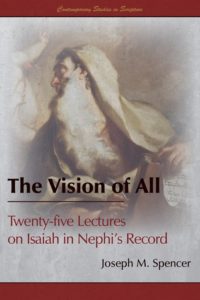 Title: The Vision of All: Twenty-Five Lectures on Isaiah in Nephi’s Record
Title: The Vision of All: Twenty-Five Lectures on Isaiah in Nephi’s Record
Author: Joseph M. Spencer
Publisher: Greg Kofford Books
Genre: Scripture studies
Year Published: 2016
Number of Pages: 312
Reviewed by Erik Champenois
The Vision of All covers the centrality and significance of Isaiah in First Nephi and Second Nephi of the Book of Mormon. It does so in a conversational, lecture-style kind of way – a style I’m not a big fan of but which likely makes the book accessible to a wider audience than might otherwise have been the case.
The book was most illuminating in showing how the structure of Nephi’s record (1 and 2 Nephi) is completely centered around Isaiah. Spencer shows that 2 Nephi 6-30 (which includes Isaiah 49:22-52:1-2 and the very long block of Isaiah 2-14) is the core of Nephi’s message and that these chapters are the “more sacred” things Nephi was commanded by God to write. He shows us this by paying careful attention to the statements of Nephi in the text: in 1 Nephi 19:3-5, Nephi tells us that he was commanded to write “the more sacred things” or “the ministry and the prophecies, the more plain and precious parts of them” and that he will write these after giving an account of making the small plates. In 2 Nephi 5, Nephi gives that account, and then proceeds to draw on Isaiah, first through his brother Jacob and then through his own elucidation. 2 Nephi 30 then has Nephi “make an end of [his] sayings.” Everything before 2 Nephi 6 and after 2 Nephi 30 is therefore seen as either leading up to, and introducing us to, the Isaiah chapters, or adding to Nephi’s record of the “more sacred things.”
Spencer shows how 1 Nephi introduces us to 2 Nephi 6-30 by giving an account of how the Nephites received the Biblical prophetic tradition (through the brass plates) and how they started their own prophetic tradition (through the visions of Lehi and Nephi). He makes clear that in both instances these are introductory to Nephi’s coverage and treatment of Isaiah – first by showing how Nephi had Isaiah in the first place, and secondly by showing that Nephi interprets – or likens and applies – Isaiah on the basis of his own visions of the future. Vision of All is particularly noteworthy for showing just how carefully Nephi reads Isaiah, paying attention to small textual details to then liken – and in some cases expand – those writings to a context not originally envisioned by Isaiah. This prophetic tradition of building on, likening, and expanding prior writings puts Nephi squarely within a prophetic tradition utilized by both New Testament writers and Joseph Smith.
Given the style of writing, and the intent to reach a broad audience, Vision of All was not as academic as I’d wish it would have been. Indeed, the book seems to draw slightly more on conservative Biblical scholarship, all while drawing on and juxtaposing liberal and conservative authors as important to read. This is understandable, especially given the problem that Deutero-Isaiah is to the historicity of the Book of Mormon. Spencer does cover this issue, but doesn’t tackle it in depth and instead proposes that, given the Book of Mormon, Deutero-Isaiah may have been contemporary to Lehi, or that perhaps there was only one Isaiah after all. He does interestingly note the absence of Third Isaiah from the Book of Mormon (there are allusions to Third Isaiah, which one could ascribe to Joseph Smith’s translation, but Third Isaiah is not quoted at length or integrated into the sermons and prophecies of the Book of Mormon the way First and Second Isaiah are).
But Spencer’s approach also draws on an illuminating and close reading of 2 Nephi 27, which quotes and significantly expands Isaiah 29. Here Nephi tells us that “the learned” need to not focus on historical evidence (seeing the sealed book or other more concrete evidences) but should instead focus on the text and meaning of the Book of Mormon. Applying these verses to believing readers of the Book of Mormon, and not just to critics, Spencer argues that focusing on “the book” or material evidence for the Book of Mormon rather than “the words of the book” is missing the point – and that Nephi here is telling us that basically we’re supposed to be reading a book that speaks like a voice from the dead, cut off from material evidence, so that we focus on the message with faith rather than on proofs and apologetics. And that’s exactly what Spencer himself has done here – read Isaiah through its starting point in the Book of Mormon, and then secondarily used academic scholarship to inform and deepen our understanding of the text.
